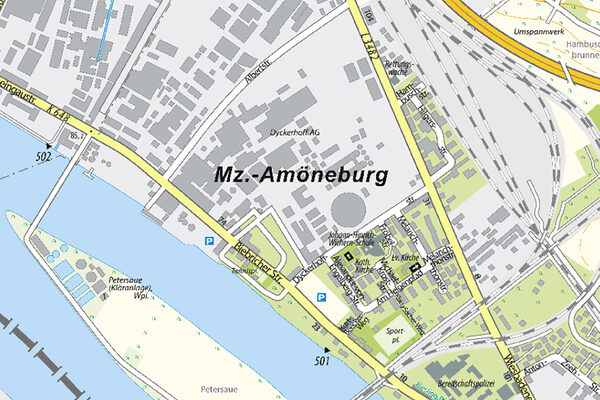Amöneburg: Small - but known worldwide
Amöneburg stretches along the Rhine and took off as an industrial location at the end of the 19th century.
Location and connection
Amöneburg lies 97 meters above sea level on the Upper Rhine between Mainz-Kastel and Wiesbaden-Biebrich. It also briefly borders Wiesbaden-Erbenheim to the north-east. The border with Biebrich runs through the Wiesbaden-Ost railroad station and the Kalle-Albert industrial park. The eastern border with Kastel is formed by the Mainz bypass and the Nordbrücke bridge. Thanks to its good transport connections and proximity to Wiesbaden and Mainz, Amöneburg is an attractive place to live and work.
Success stories
Dyckerhoff AG, which was founded in Amoeneburg in 1864 and was the largest cement factory in the world at the end of the 19th century. Chemische Werke H. & E. Albert also has its roots in Amoeneburg: in 1861, the company moved to the neighboring town of Amoeneburg, then part of Hesse-Darmstadt, in search of a new location for its expanding business. The Kalle-Albert industrial park, now operated by Infraserv, is an important industrial site in Amöneburg and neighboring Biebrich.
Quality of life
Today, the citizens are proud of their district, which is characterized by innovative environmental technologies. Amöneburg has developed from an industrial town with cement dust and smoking chimneys into a modern, environmentally conscious district.
Today, the townscape is characterized by modern office and residential buildings, a day care centre and a sports facility at the Kaiserbrücke bridge. The two striking church buildings are also still an important part of the townscape today.
A highlight in Amoeneburg
The Dyckerhoff cement plant has even supplied building materials to New York: Since 1885, the Statue of Liberty has stood on a foundation made of Dyckerhoff Portland cement.
From the statistics
More households with children live in Amöneburg than in the other districts: an impressive 29.1 percent!
